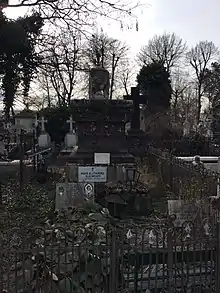Nicolae Crețulescu
Nicolae Crețulescu (Romanian pronunciation: [nikoˈla.e kret͡suˈlesku], surname also spelled Kretzulescu; 1 March 1812 – 26 June 1900) was a Wallachian, later Romanian politician and physician. He served two terms as Prime Minister of Romania: from 1862 to 1863, and from 1865 to 1866. He was elected to the Romanian Academy. He was the 3rd president of the Romanian Academy from 1872 to 1873.
Nicolae Crețulescu (Nicolae Kretzulescu) | |
|---|---|
 | |
| 2nd Prime Minister of Romania | |
| In office 24 June 1862—11 October 1863 14 June 1865 – 11 February 1866 | |
| Monarch | Alexandru Ioan Cuza |
| Preceded by | Barbu Catargiu Mihail Kogălniceanu |
| Succeeded by | Mihail Kogălniceanu Lascăr Catargiu |
| Personal details | |
| Born | March 1, 1812 Bucharest, Wallachia |
| Died | 26 June 1900 (aged 88)[1] Leordeni, Argeș County, Kingdom of Romania |
| Resting place | Bellu Cemetery, Bucharest |

Born in Bucharest, he studied medicine in Paris, having Gustave Flaubert as a colleague. As a physician, his notable work was the translation of Jean Cruveilhier's manual of anatomy.
A member of the Liberal faction, Crețulescu first became prime minister after the assassination of Barbu Catargiu, under ruler Alexandru Ioan Cuza. He avoided debating the issue of land reform, at that time the most contentious subject in Romanian politics; instead, Crețulescu focused on unifying the public health system, creating the Directorate General of the Public Archive, and establishing a Council for Public Instruction. Additionally, he laid the groundwork for further laws secularizing the property of monasteries.
References
- Giurescu, Constantin C. (2008-07-02). Viața și opera lui Cuza Vodă - Constantin C. Giurescu - Google Books. Retrieved 2012-06-20.

